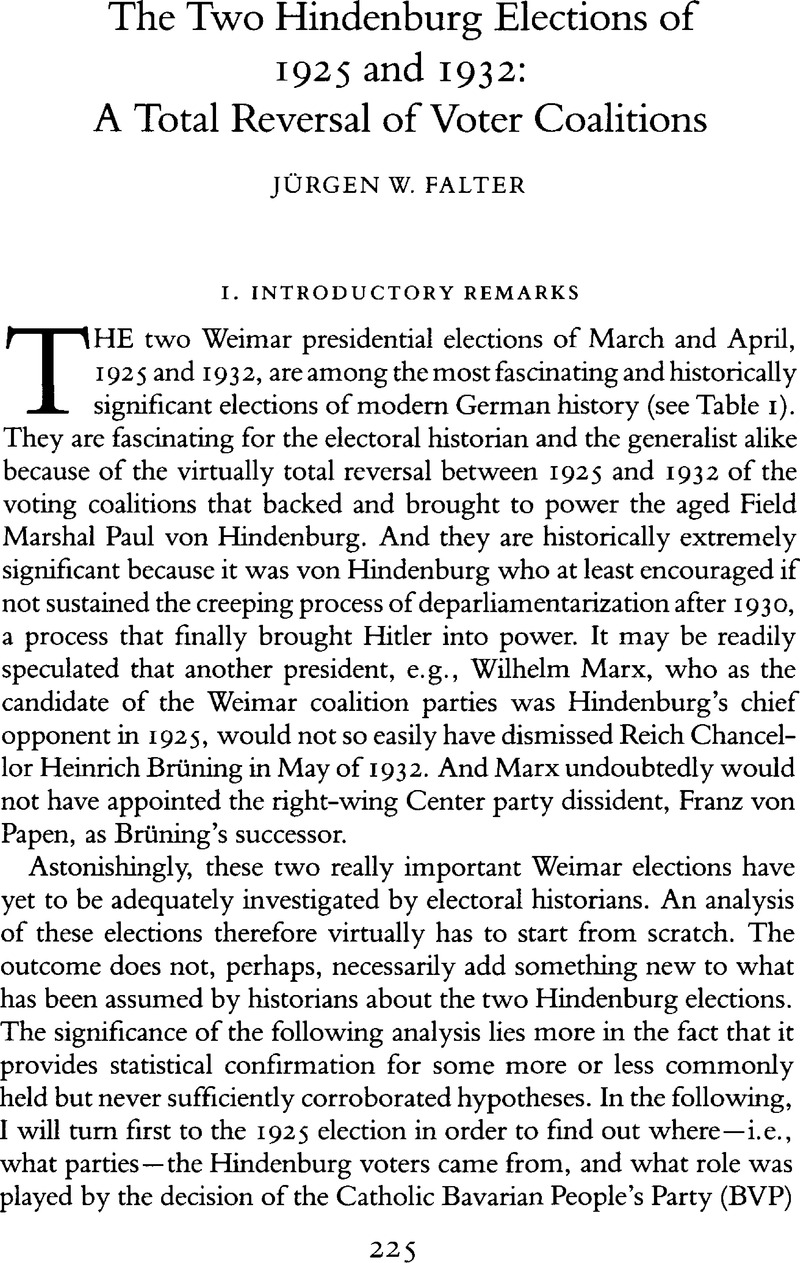Published online by Cambridge University Press: 16 December 2008

1. This analytical tool was first proposed by the German statistician Bernstein, Fritz (“Über eine Methode, die soziologische und bevölkerungsstatistische Gliederung von Abstimmungen bei geheimen Wahlverfahren statistisch zu ermitteln,” Allgemeines Statistisches Archiv 22 [1932]: 253–56).Google Scholar It was reinvented some 20 years later by Goodman, Leo A., “Ecologial Regressions and the Behavior of Individuals,” American Sociological Review 43 (1953): 557–72.Google Scholar For a comparison of the two versions of ecological regression see Lohmöller, Jan-Bernd and Falter, Jürgen W., “Some Further Aspects of Ecological Regression Analysis,” Quality and Quantity 20 (1986): 109–25.CrossRefGoogle Scholar Still one of the best introductions to ecological regression analysis for historians is an article by Kousser, Morgan, “Ecological Regression and the Analysis of Past Politics,” Journal of Inderdisciplinary History 4 (1973/1974): 237–62.CrossRefGoogle Scholar
2. For some formal aspects of this data set which contains about 1,200 cases and more than 700 variables see Hänisch, Dirk, “Inhalt und Struktur der Datenbank ‘Wahl-und Sozialdaten der Kreise und Gemeinden des Deutschen Reiches von 1920–1933‘,“ Historical Social Research 14 (1989): 39–67Google Scholar. The ICPSR data set on Weimar elections unfortunately has some serious shortcomings which make it not advisable to use it without major revisions. See Falter, Jürgen W. and Gruner, Wolf D., “Minor and Major Flaws of a Widely Used Data Set: The ICPSR ‘German Weimar Republic Data 1919–1933’ under Scrutiny,” Historical Social Research 6 (1981): 1–26.Google Scholar
3. See Alker, Hayward R. Jr., “A Typology of Ecological Fallacies,” in Dogan, Mattei and Rokkan, Stein, eds., Quantitative Ecological Analysis in the Social Sciences (Cambridge, Mass., 1969), 69–86.Google ScholarRobinson, W. S., “Ecological Correlations and the Behavier of Individuals,” American Sociological Review 40 (1950): 351–57.CrossRefGoogle Scholar
4. To control for the effect of nonlinear, contextual influences in the following an extension of multiple ecologialo regression analysis with product variables is used. For detalies see Lohmöller, Jan-Bernd et al. , “Unemployment and the Rise of National Socialism: Contradicting Results from Different Regional Aggregations,” in Nijkamp, Peter, ed., Measuring the Unmeasurable (The Hague, 1985), 357–70.CrossRefGoogle Scholar Also Falter, Jürgen W. and Zintl, Reinhard, “The Economic Crisis of the 1930's and the Nazi Vote: An Attempt at Explanation by Means of a Rational Choice Approach and Ecological Regression Analysis,” Journal of Interdisciplinary History 19 (1988): 55–85.CrossRefGoogle Scholar
5. See Falter, and Zintl, , “The Economic Crisis of the 1930's and the Nazi Vote,” also Falter, Jürgen W., “The National Socialist Mobilisation of Voters: 1928–1933,” in Childers, Thomas, ed., The Formation of the Nazi Constituency 1919–1933 (London, 1986), 202–31.Google Scholar
6. Regional results in Falter, Jürgen W. et al. , Wahlen und Abstimmungen in der Weimarer Republik: Materialien Zum Wahlverhalten 1919–1933 (Munich, 1986), 46, 73–79.Google Scholar
7. See Bracher, Karl Dietrich, Die Auflösung der Weimarer Republik: Eine Studie zum Problem des Machtzerfalls in der Demokratie (Villingen, 1955), 443–80.Google Scholar
8. Quite unexpectedly the Nazis fared much better in districts with low levels of unemployment. On the average, the unemployed seem to have been cleary underrepresented among Nazivoters. See Falter, Jürgen W., “Unemployment and the Radicalisation of the German Electorate 1928–1933: An Aggregate Data Analysis with Special Emphasis on the Rise of National Socialism,” in Stachura, Peter, ed., Umemployment and the Great Depression in Weimar Germany (Houndsmill/London, 1986), 187–208CrossRefGoogle Scholar, and Falter, Jürgen W., Hitlers Wähler (Munich, 1991), 292–314.Google Scholar
9. Analogus “trees” for all major parties and Weimar elections are presented in Falyter, Jürgen W. et al. , Wahlen und Abstimmungen in der Weimarer Republik, 194–203.Google Scholar
10. In fact in the multivariate model the Hindenburg vote of 1925 (which in turn may be interpreted as a proximity measure of a right-wing political tradition) is the second best predictor of the Nazi vote (after the religious of the counties)! See Falter, Jürgen W. and Hänisch, Dirk, “Die Anfälligkeit von Arbeitern gegenüber der NSDAP bei den Reichstagswahlen 1928–1933,” Archiv für Sozialgeschichte 26 (1986): 179–216.Google Scholar
11. See Milatz, Alfred, Wahlen und Wähler in der Weimarer Republik (Bonn, 1965), 138–36, 141.Google Scholar